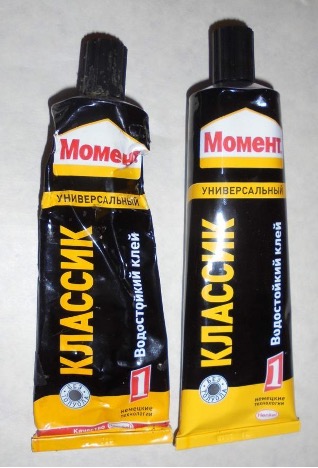Filed Under: Material culture > Entertainment > Klei-Moment
Klei-Moment

Moment glue first appeared in the Soviet Union in 1979, promising to be the most effective glue for all sorts of hobby and homemaking needs. It was made at the Tosno plant outside Leningrad using technology purchased from the West German chemical concern Henkel. But in the 1990s, it became a cult object for another reason. Moment glue contained a toxicological agent called toluene, which, along with methanol-chloride, produced hallucinatory effects if inhaled. Moment glue became a major player (or at least a major symbol) in the rising tide of drug use in post-Soviet Russia, especially among minors, who could buy the glue cheaply and with relative ease. As the tabloid Argumenty i fakty reported in 1997, “in Moscow, almost half of boys and a quarter of girls surveyed admitted to trying narcotics at least once.” Since a gram of heroin cost around $100, “schoolchildren seek out cheaper modes of psycho-stimulation and huff Moment glue.”
Henkel, which had acquired a controlling stake when the Tosno plant was privatized in 1993, realized they had a public relations problem on their hands and worked to reformulate the glue with new, non-hallucinogenic ingredients. But by the time the new recipe went into production, it was too late. Moment glue had entered the culture as a byword for drug use. It was featured in “Gandbol,” a song by the popular band Spleen—still many Russians’ first association with the brand—and its narcotic uses all but eclipsed its stickier properties. A contemporary joke featuring the glue attested to its problematic reputation:
Henkel, which had acquired a controlling stake when the Tosno plant was privatized in 1993, realized they had a public relations problem on their hands and worked to reformulate the glue with new, non-hallucinogenic ingredients. But by the time the new recipe went into production, it was too late. Moment glue had entered the culture as a byword for drug use. It was featured in “Gandbol,” a song by the popular band Spleen—still many Russians’ first association with the brand—and its narcotic uses all but eclipsed its stickier properties. A contemporary joke featuring the glue attested to its problematic reputation:
Boy: Miss, a tube of Moment glue, please.
Saleswoman: You an addict?
Boy: No, my shoe is falling apart.
Saleswoman: So you think if you huff Moment, your shoe will miraculously repair itself?
The saleswoman’s disbelief is emblematic. She can no longer believe that this utilitarian product, created for hobbyists and DIYers, could be used for repair. In the context of a society coming apart at its seams, glue’s physical properties were replaced by its psychedelic promise, and its use value was no longer adhesion but escapist intoxication.